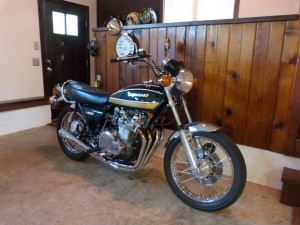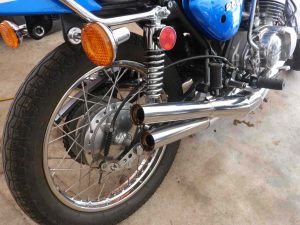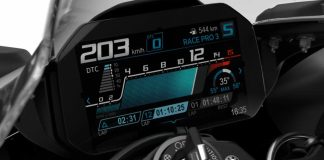Here’s the latest reader question, along with my reply!
Kenny asks: I haven’t seen anything much by you about the latest bikes. Have you given up on them?
My reply: It’s more like I’m not interested in them. Yes, yes – they’ve never been more powerful, quick/fast and reliable, etc. All true. They have also never been more expensive, homogenous and unapproachable – which I am convinced accounts for the declining interest in motorcycles among people under 35.
Modern sport bikes are the worst – despite being the best, in terms of the numbers. But there’s no longer much difference between a Honda and a Kaw and a Yamaha and a Suzuki . . . other than the color of the plastic. 
They’re all immensely powerful and capable. But their capabilities are now so far ahead of the capabilities of the typical rider that it’s less fun to ride them. They are like a girl completely out of your league. You manage to get a date but your dick’s not big enough or doesn’t stay hard long enough or doesn’t get hard again soon enough. She’s disappointed – and you’re embarrassed.
The old stuff had less power – but much more character. And you could really push yourself on the bike, without getting so far ahead of yourself that death was probable if anything went awry. This is analogous to the deal with new cars. The new Corvette, for example, can do things no prior Corvette could have attempted – or would have failed if attempted. But because of this, driving one at 90 MPH is as boring as driving a ’78 L-82 Corvette at 55.
And you could work on the ’78. 
The new one – like new bikes – is a miasma of electronics and software and proprietary systems that requires high-order skills and expensive tools. If you’re not a professional technician – or at the skill level of one – and don’t have the tool kit of a professional technician – a modern car or a modern bike is something alienating because you don’t really have any control over it.
But I remain very interested in anything – two wheels or four – made before computers and cod piecing ruined everything.
. . .
Got a question about cars, Libertarian politics – or anything else? Click on the “ask Eric” link and send ’em in!
If you like what you’ve found here please consider supporting EPautos.
We depend on you to keep the wheels turning!
Our donate button is here.
If you prefer not to use PayPal, our mailing address is:
EPautos
721 Hummingbird Lane SE
Copper Hill, VA 24079
PS: Get an EPautos magnet (pictured below) in return for a $20 or more one-time donation or a $10 or more monthly recurring donation. (Please be sure to tell us you want a sticker – and also, provide an address, so we know where to mail the thing!)
My latest eBook is also available for your favorite price – free! Click here. 












There a a few new bikes out that are OK. I picked up a Kawasaki X300 and it is the most fun bike that I have had for a while. Ninja motor (tuned differently), 385 lbs, 300 miles to a tank, upright seating, OK for gravel roads, will cruise at 80mph (might be different for a big guy and hills/headwinds) —– and it likes to be run in the 8,000+ RPM range (with minimal vibration). Out the door for $5k. Two things that are troublesome are the tube tires (pain in the ass to change out on the side of the rode and ABS that is not switchable. ABS might be cured by pulling a fuse or putting in a switch, similar to what’s available for a CB500X, but I haven’t investigated that yet).
One other bike you might look at is Janus. They have some very cool, basic bikes, but their engines are sourced in China.
I may pull the trigger on the Gryfinn later this winter. https://www.janusmotorcycles.com/gryffin-250-scrambler-motorcycle
Would be cool if you could do a ride report on one of those.
Anon
I’ll say I agree that sport bikes from the Big 4 Japanese manufacturers with the addition of the BMW S1000RR are all pretty interchangeable. Sure, the Yamaha R1 has a cross-plane engine that sounds cool, and the BMW has that funky asymmetrical face, but there really are only subtle differences across the board. Heck, even the Italian brands that for years stuck their guns with twins are now using 4-cylinder engines.
These similarities of course come down to rules. All cars are largely the same nowadays because of crash worthiness and fuel economy regulations (you mention this all the time), and bikes seem to be largely the same because they’re conforming to race regulations and the sport bikes are homologations from those rules. Someone’s gotta break the rules to make something different, but then they can’t race it! (Kawasaki is actually kind of doing that, since they don’t race the ZX1000 and it’s closer to a sport-touring bike than a race replica, and then they go and make the H2 which is way too bonkers to race.)
Of course this across-brand sameness really in truth has always been here with Japanese motorcycles, right? Honda launches the CB750 in 1969 and within a few years a whole range of 4-cylinder naked sport bikes from all Japanese manufacturers are so common and virtually interchangeable that they called those things Universal Japanese Motorcycles, or UJMs. Can’t see why things are really any better back then than they are now.
Of course once you look beyond the full-fairing race replica bikes even the Japanese brands start to have some individual character to them. There’s nothing more Honda that’s ever been manufactured than my VFR800 with its V4 engine. Kawasaki makes bonkers supercharged green bikes, and have just announced a 250cc 4-cylinder bike with a nearly 20,000 RPM redline. Yamaha has their innovative cross-plane 4 cylinder and their torquey 3-cylinders. Suzuki is sort of the most “generic” of the bunch I guess but that’s ok.
(As to why BMW had to go make a Japanese supersport, the S1000RR, and just prove the point of those sorts of bikes being generic… I can’t answer. BMW is still king in the “ADV” (adventure) bike sphere that they pioneered with their GS bike. Good for them.)
Point is, differences between Japanese motorcycle brands have always been subtle. If you wanted a different character of bike, you had to look beyond to Bavaria, Italy, England, and America.
And while motorcycles are getting more and more electronic, carbureted models are still available, ABS (outside of Europe) is still an option, as is TCS. Some bikes have electronic throttles, but some still have cable-operated throttles. Almost all bikes still have manual transmissions. Electric motorcycles are a largely ignored curiosity rather than being foisted on the public as the inevitable future. Motorcycles for now look to be in better shape than cars.
I agree with most of your rant about new bikes Eric. BUT, they still are a far cry from having all the mandated safety crap on cars. I’ve recently gotten into ‘adventure’ bikes and I am having a ton of fun. One new and one old. Still fun, fun, fun. Still shift, still almost everything, and while the new one has all kinds of traction controls, abs, lean stuff, on this particular bike you can turn it all off if you want.
Hi Chris,
Amen – but give them time. Not just the government, either. The bike MFGRs are going all-in on saaaaaaaaaaaaaaaaaaafety, too. Note linked brakes,b ABS, TCS… only a matter of time before they begin installing automated emergency braking, etc.
When I bought my Harley, I specifically got a 2000 Dyna b/c it was the last year of a carburetor in any big twin. Harley’s these days are like cars. Boring. Hell, guys are even keeping the stock pipes!
Eric,
I think you’re on to something here. I have three scooters, two of which are road worthy right now: a 2011 Suzuki Burgman 400, and a 2004 Honda Helix.
The Burgman is the better machine, hands down; it’s heavier, faster, and more stable. It’s more a motorcycle than scooter. However, it’s so covered up it’s a PITA to work on; there’s a ton of “Tupperware” that needs to be removed before you do anything on it. It has fuel injection and all the modern trimmings. When you do, it’ll be harder to do anything. Oh, and it has a linked braking system on it! The Burgman, wonderful though it is, feels like an appliance-probably because it is.
The Helix has the 250cc engine & tranny that came out of the old Elite 250. It’s water cooled but very under stressed, and-get this-it’s carbureted! Guys have ridden the Elite 250 around the world; since the Helix uses the same engine and drivetrain, it’s uber reliable. The Helix is smaller and lighter than my Burgman; it looks, feels, and acts like a scooter. It’ll do 70-72 flat out on flat ground. Even so, you don’t want to hit the super slab unless it’s only for a few miles to go from one exit to the next. It’s happiest in the city or secondary roads. It’s sweet spot, speed wise, is about 45-55.
All that said, the bike is easy to work on. The seat is easy to remove, and gives you access to the upper part of the engine room. If you pull the muffler off, you can have access to the lower portion. Few special tools are needed to work on the Helix. If you have a good set of hand tools (like a Craftsman mechanics tool set), you can do most of your own work. Wheels are east to remove and put back on.
When I put new tires on, I’d pull one wheel, take it to the shop, and have ’em change the tire. Then I’d come back, pull the other wheel, and take it to the shop. The first wheel would have the new tire on it, so I’d swap ’em; I’d hand the man the wheel I just pulled (with the old tire on it), then take the one with the fresh tire. I’d go back and put that wheel on. Then I’d go back, pick up the 2nd wheel, and put it on. Because the tires are small, they’d only charge me $15 to change the tires. Anyone who’s even learning about mechanics can work on the Helix. Just get yourself a shop manual (or download one), get a set of tools, and get to work… 🙂
The Helix was originally designed in 1987 or thereabouts, so it has just basic electronic ignition. It has a carburetor, not fuel injection. It has an LED instrument cluster. It remained in production for about 20 years. The only MAJOR change they made to the Helix was to change from steel wheels to aluminum for 1993. Everything else stayed the same. All that ever changed from one year to the next was the color. Even though it’s not the better machine, it’s more SATISFYING; it’s more satisfying because it’s more basic, and pretty much anyone can learn to work on one.
Now, if I can touch on bikes for a minute, back in the day, the brands were more differentiated. Kawasaki, up until the early 2000s, was especially the maverick brand. If you wanted balls to the wall, scare the crap out of you performance, you bought a Kawasaki. Anyone who rode the 750 triple will tell you that that machine was a BEAST! Their 900 Z1 was the first superbike. The early ’00s ZX-10s are, shall we say, challenging and scary machines? Read any review on the older ZX-10s, and they’ll tell you that you’d BETTER know what you’re doing if you want to live any length of time. The ZX-11 of the early ’90s was the fastest production bike on the planet in its day! My old ZRX1100 had the same engine as the ZX-11, though it was retuned more for midrange grunt. While the ZRX was the fastest machine I ever owned, I never felt like I could totally relax and simply ENJOY the ride; I always felt like I was riding a cranky, temperamental thoroughbred race horse just waiting for an excuse to throw me. That’s what Kawasaki was all about-raw performance. That and its bright green color were Kawasaki’s calling cards…
Of course, if you wanted reliability, Honda was the brand you went with. Hondas were the most reliable machines on the planet-end of story. They were reliable to the point of being boring! Just change the oil once in a while and keep the tank full, and a Honda would give tens of thousands of trouble free miles. Honda set the BENCHMARK in terms of reliability. If you were going to build a vehicle, either two or four wheel, it had better have the reliability of a Honda…
Yamahas and Suzukis were in between the extremes of reliability vs. performance; they were between Honda and Kawasaki. Yamahas were mostly Honda like with a bit of Kawasaki performance mixed in. Suzukis, OTOH, were more Kawi like (leaned more towards performance) with Honda reliability mixed in. Anyway, there were, at one time, meaningful differences between bikes from the Big Four. Now, not so much.
Anyway, those are my rambing, somewhat incoherent thoughts…